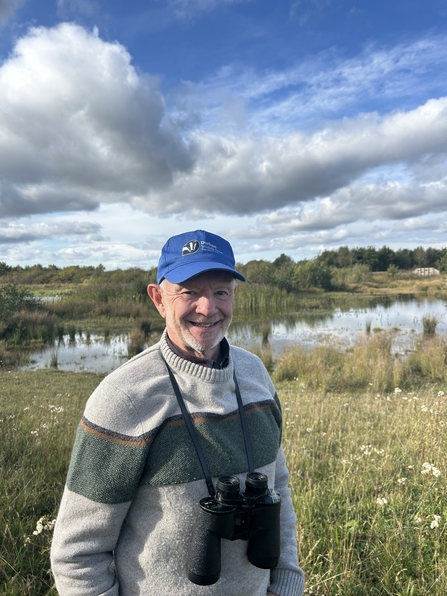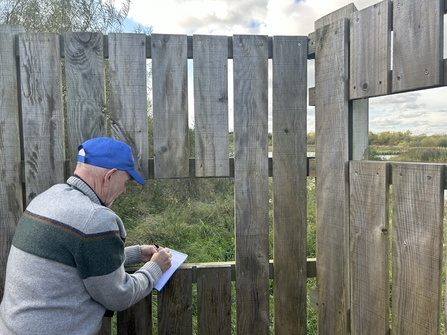Who would have thought walking around Rainton Meadows, once a month, keeping a count of of our wetland birds could make such a difference to health and happiness? Not me, five years ago. Let me tell you how I discovered some of the secrets to improving my physical and mental well-being through a very simple process of connecting to nature.
Citizen science: the wellness effect

Mike Willshare at Rainton Meadows Nature Reserve
Rainton Meadows and me
I’m Mike Willshare and I’ve been a Durham Wildlife Trust volunteer at Rainton Meadows for just over five years, beginning shortly after retiring from the technology industry. I spent a lot of my working life in factories, offices, company cars and aeroplanes, NOT being connected to nature. I’m not really a naturalist, or a scientist, or a conservationist but I’ve always been quite curious about the natural world. I live just a couple of miles down the road from Rainton Meadows and, like many local people, have been a casual visitor for many years. I just enjoyed being out in the open woodland and the fresh air at the weekend.
Once we retired my wife, Linda, and I both became members and volunteers of Durham Wildlife Trust. We spend a day a week 'on task' either at Rainton Meadows or one of the other sites around County Durham managed by the Trust. It’s great being out in the open, enjoying fresh air and giving something back. It’s also a great way to meet new people and make new friends of all ages and backgrounds.
Bird counting
While working as a volunteer at Rainton Meadows it's really difficult NOT to notice the abundance and variety of wild birds around the reserve. One day, out on task, my curiosity about the wildlife got the better of me. I asked the Reserves Manager at Rainton if anyone kept track of how the different birds came and went through the seasons. ”Were they all resident birds? Were they migrating birds? Did their numbers vary throughout the year? Did they come hear to breed?”
He thought for a moment then said, “Funny you should say that. I know that the British Trust for Ornithology (BTO) need a new volunteer to carry out a monthly count of the wetland birds at Rainton. It would be the perfect way to find out for yourself.” I said I didn’t know much about birds. I didn’t know the difference between a Mallard and a Moorhen. But he told me the BTO have plenty of resources and training to help identify the birds and how to count them. So he took me round the reserve, gave me some tips on where and how to look for the different species and signed me up with the BTO. I’ve been doing the monthly count at Rainton ever since.

Mike Willshare bird watching over ponds as part of citizen science bird recording
Mike, The Citizen Scientist
The bird count I perform for the BTO is called the Wetland Bird Survey (WeBS). It turns out I’m one of more than 3,000 volunteers across the country who carry out the bird count on the same Sunday of each month. All of the data collected by volunteers goes into probably the largest and oldest database in the world for wetland birds. Scientists can get free access to all of the data to carry out whatever research they like.
It’s a great example of 'citizen science' where members of the public, like me, who have no particular scientific skills can make a huge contribution to our understanding of wetland bird behaviour. In turn, this leads to more informed decisions about how to manage our environment to help species that are under threat, such as curlews and lapwings, for example.

Mike Willshare carrying out bird recording at Rainton Meadows
The wellness effect
Once a month I walk most of the perimeter of Rainton Meadows and count any wetland birds I see. I walk about 3.5 miles, making sure I visit each of the five main ponds. It takes me about 3 hours. I’m not looking for every single bird I can find, just a snapshot of what is there at the time, and make a record of what I see at each location.
I never thought of the bird count as having any particular benefits on my health but here’s what I’ve discovered about the effects on my wellness. There seem to three levels of benefits that kick in at different stages:
- Level One - Starting my round of the reserve I find I’m 'disconnecting' myself from the hustle and bustle, and the stresses and strains of 21st century life. I think of it as decompression.
- Level Two - After 30 minutes or so I feel more relaxed and revitalised, just as I would on any walk through woodland or perhaps at the beach.
- Level Three - This is the big difference for me. It’s only when I stop to use my binoculars to count the birds, and start to observe them in some detail, that I feel 'reconnected' with nature. They may be resting in groups, teaching their young to find food, or taking to the air to move on. Whatever they’re doing, while I’m watching these animals all my other cares and anxieties melt away. Understanding some of their struggles in their natural environment is a great way of putting our personal worries into perspective.
Through watching and counting the birds I’m making a contribution to science at the same time as contributing to my own personal wellness. Win, win!
